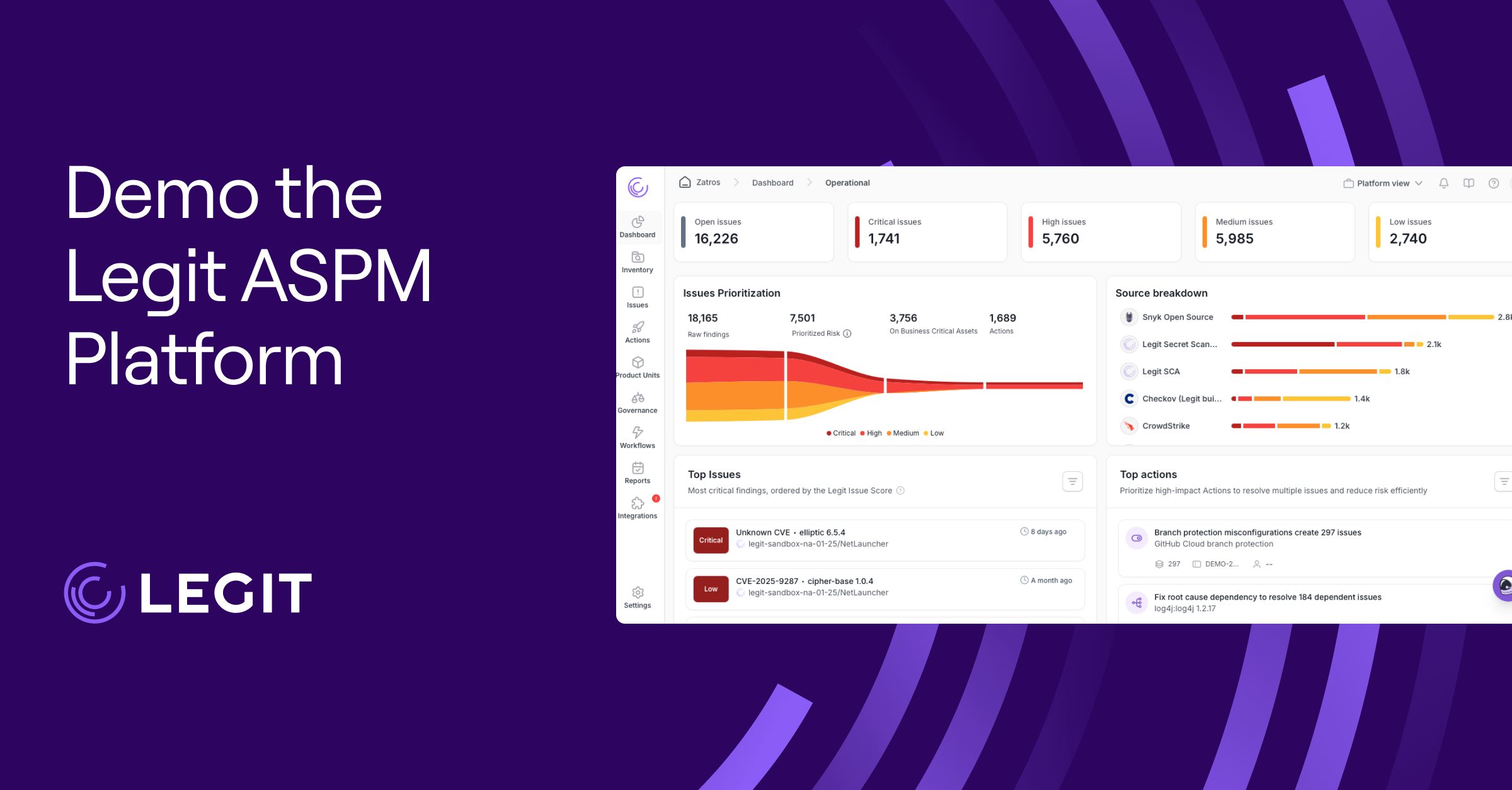The integration of automated DevOps tools into the security landscape has marked a significant shift in how businesses approach software and application security. Given the increased complexity involved in securing the SDLC, organizations need to find ways to comprehensively secure their assets in software development while balancing the effort, time, and burden of that responsibility.
This article will explore automated DevOps security, highlight the crucial role it has in preventing breaches, providing robust application security, and how these solutions are shaping the future of DevSecOps.
Why Preventing Breaches Works Better with Automation
Data breaches aren’t going anywhere. Threat actors continue to look for more and more areas to compromise companies, focusing their attention on development environments and attacking companies at a crucial juncture — the software supply chain. This has led to an urgent need for updated and enhanced security measures.
The never-ending cycle of data breaches shows us that traditional security approaches are no longer sufficient. By relying on overly manual and outdated security processes, organizations inadvertently open themselves up to risks that could be mitigated more effectively through automation, while finding themselves hindered by departments with limited time and resources. Automated security measures in DevSecOps integrate security protocols earlier in the Software Development Life Cycle (SDLC), thereby minimizing the human error factor.
Across the supply chain, we’ve found multiple instances of risks and vulnerabilities that have led to critical asset and sensitive data exposure. Recently, we reported on the artifact storage leak risk found in Jfrog Artifactory, a binary repository manager. Artifactory is a centralized platform that supports multiple repository formats and integrates with popular CI/CD tools. However, accidental misconfiguration can lead to publicly exposed artifacts and threat actors can exploit anonymous access via unauthorized modifications. In our investigation, we found that over 30% of public Artifact instances allowed anonymous access and 70% of those were using a legacy version that exposed them to a known authentication bypass vulnerability.
We also found vulnerabilities in SonarQube, an open-source SAST platform (code scanner), as well as multiple misconfigurations such as publicly exposed SonarQube instances. Of the 2200 public instances we reviewed, 200 allowed anonymous access and revealed secrets in the form of API tokens, keys, and sensitive information on both employees and customers. This can easily lead to a data breach if the wrong threat actor finds these public instances.
These examples highlight the critical role of automation in cybersecurity. Automated solutions are designed to enable thorough security checks, minimize human error, and provide comprehensive protection at scale, across multiple components and platforms within SDLC security while streamlining the development process. This ensures misconfigurations and easy to remediate vulnerabilities aren’t left exposing organizations to unnecessary risk.
Automated security in DevSecOps is a necessary evolution to effectively combat cyber threats and risks that come with a complicated cloud-based developer environment. Not only does it provide the comprehensive protection required, it addresses many of the operational issues companies commonly face in trying to secure their entire SDLC.
Benefits of Using Automated DevOps Security Tools
Integrating automated DevOps security tools into the Software Development Life Cycle (SDLC) will streamline processes, enhance security, and optimize resource utilization, vastly improving a department’s overall efficiency and effectiveness. This is delivered via the following capabilities:
Accelerated SDLC Process:
Automated tools can help significantly reduce the time to market by speeding up a secure SDLC process. This allows for quicker deployment of applications in a comprehensively secure manner, fostering agility and responsiveness without compromising on security.
Enhanced Accuracy in Code Checks:
These tools can provide more accurate and comprehensive code checks and verifications, which not only reduce the amount of time it takes to manually review code but also increase the chance of finding vulnerabilities and remediating them before they lead to a compromise.
Uniform Security Protections:
Automated DevSecOps tools offer uniform and consistent security measures across all stages of development. This allows for easier management and eases the burden teams often feel with multiple security solutions with varying elements of security capabilities.
Reduction in Manual Tasks:
The automation of security tasks significantly reduces the volume of manual work required throughout each phase of the SDLC. This streamlines secure software development and allows developers to focus on product innovation and other more critical activities.
Scalability with Application Growth:
As developer environments grow and evolve, security becomes an issue if the right tools aren’t utilized. Automated solutions are designed to easily scale to meet changing needs, allowing an organization’s application development processes to grow effectively and securely.
Simplified Regulatory Compliance:
Audit trails and compliance-related report development is automated by many of these tools, allowing organizations to better adhere to regulatory standards without needing to devote too much time or resources.
Cost-Effective Security:
The use of automated tools results in more cost-effective operations that deliver long-term benefits, like reducing the labor costs that often come with too many manual tasks, and potentially reducing the difficulty associated with an inability to fill open headcount in a security organization.
These benefits, alongside new applications within the use of AI tools for stronger threat analysis, empower DevSecOps teams to more efficiently find and remediate vulnerabilities in a way that enhances the SDLC process. It is why these tools are so important for these teams.
Best Types of Automated DevSec Tools for Every Team
We’ve explained why automated DevOps security tools are so important to a modern development department looking to safeguard their applications and assets. However, these tools come with a variety of capabilities, so it’s important to know which ones are best for organizations. Here’s a list of tools you should be considering.
Automated Static Code Analysis
Automated Static Code Analysis tools assess source code at various stages of the SDLC, identifying potential security vulnerabilities before the software or application is deployed or executed. By analyzing the code without actually running it, these tools can preemptively detect a wide range of issues, such as syntax errors, code anomalies, and security weaknesses, ensuring that the codebase remains robust and secure and vastly reducing the risk of a potential software supply chain data breach or accidental exposure. Automated static code analysis also helps organizations comply with coding standards and best practices in a much more comprehensive manner.
Automated Threat Modeling
Automated Threat Modeling tools help teams identify, understand, and address potential security threats earlier in application development. By automatically generating threat models, teams can proactively visualize how an attacker might compromise their application. This is a focused, hands-on approach that facilitates the implementation of security measures tailored to any discovered threats while giving teams an understanding of their broader attack surface, critical for developing effective DevSecOps security strategies.
Vulnerability Scanning
Automated Vulnerability Scanning tools continuously scan applications and development environments for vulnerabilities to ensure there aren’t any easily remediated risks available for threat actors to exploit. These are often open source DevSecOps tools that check against up-to-date vulnerability databases, which is especially important as companies increasingly use open-source components that open them up to software supply chain vulnerabilities. These tools are critical part of any comprehensive application security strategy and help maintain a strong security posture throughout an application’s lifecycle, from development to runtime deployment and maintenance.
AI-Powered Static Code Analysis
AI-Powered Static Code Analysis (SCA) leverages AI for faster, deeper, and more accurate SCA processes that take into account context and code semantics, resulting in a more comprehensive analysis. More complex code errors, risks and vulnerabilities that are frequently missed by traditional SCA tools are uncovered through these advanced tools, giving organizations an even more efficient and comprehensive way to analyze code. As more organizations leverage AI tools in their own software development, these tools will be able to more comprehensively scan them for potential issues.
Dynamic Application Security Testing (DAST)
Automated Dynamic Application Security Testing (DAST) tools are a complement to SCA, analyzing applications and code in their running state, simulating attacks to identify vulnerabilities that might be exploited once the application is live. Automated DAST test applications in a live environment, they can test for vulnerabilities like SQL injection attacks, cross-site scripting, and other attacks that can only exist during runtime. This is a real-time way to assess an application’s security posture and alongside automated SCA tools, give organizations a full view of their SDLC for complete comprehensive security. process.
Secure Your Code with Automated DevOps Tools
DevOps security automation represents a major step towards addressing today’s vulnerabilities and risks stemming from increasingly complicated software development environments and software supply chain risks. Automated security, particularly in the form of automated security testing, serves as a fundamental pillar in securing your entire SDLC. By implementing these automated tools, organizations have a more comprehensive, efficient, and less error-prone approach to DevSecOps.
By automating traditional manual methods, departments can maintain a streamlined approach to their software development in a secure manner, being able to identify and remediate any discovered vulnerabilities, risks, or threats, throughout the entire SDLC. This allows security to keep pace with rapid development cycles, allowing the organization to scale their production without any increased risk.
Legit Security was designed specifically for a secure SDLC, providing comprehensive asset discovery and vulnerability identification and remediation across multiple developer environments. The platform is designed to empower DevSecOps teams and streamline their security processes while facilitating an agile production workflow.
We’re looking to address the core risks within the software supply chain in a way that serves departments best rather than overwhelm them with yet another solution. To learn more about how our platform can secure your assets and applications, schedule a demo here.
Download our new whitepaper.


